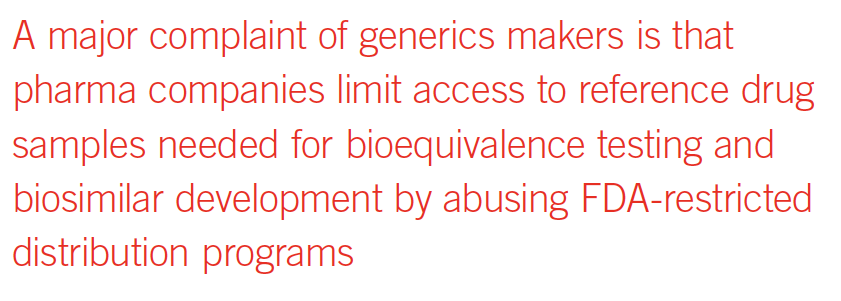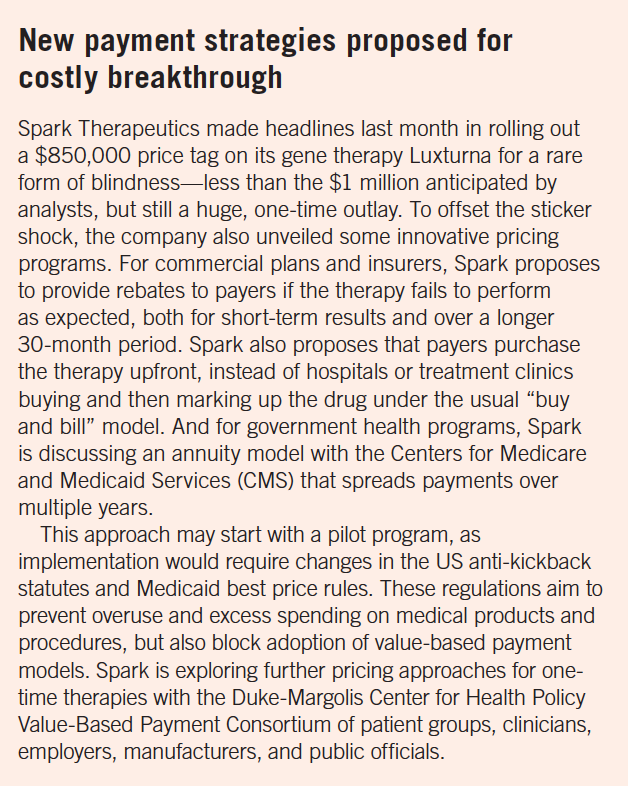More New Drugs and Generics Reshape Pharma Markets
Pharmaceutical Executive
Low-cost follow-ons and biosimilars please payers but heighten competitive battles with brands.
Amidst all the outrage over surging pharma prices, the continued growth in generic drug prescribing has moderated overall spending on medicines, cooling the political heat on industry. Generics now account for nearly 90% of prescription drug use in the US due to policies facilitating their development and regulatory approval. But while generic gains have slowed drug price inflation, the competition has hit brand revenues and
Jill Wechsler

profits. The much-anticipated growth in biosimilars, moreover, should further squeeze returns on expensive biotech therapies.
These developments are driving innovators to take advantage of strategies likely to delay the development and marketing of follow-on products. FDA has approved nine biosimilars, but only a few have come to market due to court battles over patents. A major complaint of generics makers is that pharma companies limit access to reference drug samples needed for bioequivalence testing and biosimilar development by abusing FDA-restricted distribution programs.
Competition ‘hit list’
FDA Commissioner Scott Gottlieb has responded with a campaign to increase market competition to offset such “gaming” of the drug regulatory and legal system. A main strategy involves encouraging the development and approval of complex generics and combination products, as proposed in a June 2017 Competition Action Plan. FDA also unveiled a “hit list” of more than 250 off-patent, off-exclusivity brand drugs that lack approved generic competition and thus merit FDA assistance in developing alternatives and in expediting product approvals.
At an FDA public meeting in July, manufacturers and health policy experts discussed a range of innovator actions used to block generic marketing, including citizen petitions, labeling issues, late formulation changes,

and the use of Risk Evaluation and Mitigation Strategies (REMS) to stymie new generic testing. Similar topics were raised at a November 2017 Federal Trade Commission (FTC) workshop on competition in US prescription drug markets. At that meeting, Gottlieb emphasized the importance of more streamlined development and approval of generic drugs and biosimilars and warned pharma companies to “end the shenanigans” that delay competition and extend a drug’s monopoly beyond intended timeframes.
FDA also has published more product-specific guidance documents to help speed approval of complex products, synthetic peptides, and generic versions of opioids with abuse-deterrent features. Agency workshops last fall discussed strategies for developing complex dosage forms where traditional bioequivalency and bioavailability tests may not support approval. Further FDA advisories will address development of difficult formulations, such as ophthalmic suspensions, gels, and inhaled drugs. And FDA is offering to meet with generics manufacturers to discuss R&D issues, such as how labeling can address design differences between a generic and brand.
Equally important are agency efforts to streamline the process for evaluating and reviewing all new generics. FDA approved more than 1,000 new generic drugs last year under a more automated review process supported by generic drug user fees. The added resources helped reduce a huge backlog in unapproved products and achieve a more predictable review process.
Seeking balance
At the same time, FDA approved a record 46 innovative new drugs in 2017, plus landmark gene and CAR-T cellular therapies and vaccines regulated as biologics. With thousands of new medicines in the R&D pipeline, these trends are likely to continue, bolstered by FDA flexibility in the development and review of important breakthrough therapies.
The challenge to FDA and industry is to maintain a balance between encouraging the development of

important new medical therapies and assuring access to low-cost follow-on medicines. Biopharma companies emphasize the need for incentives to test new therapies and to develop added indications to an approved product. Yet, driving change through increased competition is an uncertain business. FDA support for generics is visible in its recent approval of the first generic version of the leading multiple sclerosis therapy Copaxone, and the rejection of efforts by Allergan to block generic competition to its blockbuster eye drug Restasis. But so far, there has been limited industry response to FDA’s list of drugs that lack generic competition, as many products involve small markets and costly R&D processes.
More new drug approvals are good news for sponsors, but that also can spur competition within a drug class, as seen with hepatitis C therapies. And while there’s public outrage over steep hikes on drugs to treat rare conditions, as with a 1,400% increase on a 40-year-old drug now used to treat certain brain tumors, such moves have less impact on broader spending than the annual price hikes on big-selling treatments for depression, high cholesterol, and rheumatoid arthritis. Even though industry leaders kept recent increases on such drugs under 10%, as promised, these modest hikes are the main drivers of revenues and profits.
Meanwhile, generics makers claim that the squeeze on revenues due to anticompetitive brand tactics, along with distributor and wholesaler consolidation, discourages their investment in modern manufacturing systems needed to ensure product safety and quality and avoid recalls and shortages. Teva Pharmaceuticals is instituting massive layoffs and shuttering manufacturing and R&D facilities to regain financial health. Novartis’ Sandoz division says that price pressures may lead to reductions in its US product portfolio and a greater focus on developing biosimilars and complex formulations. And high-profile price increases on older generic products have generated backlashes and allegations of collusion and price gouging, particularly from state prosecutors.
Congress is paying attention to these developments as it continues to weigh proposals for managing drug costs and outlays. The House Judiciary Committee examined barriers to generic drug development at a hearing in July 2017. In December, the House Energy & Commerce Health subcommittee discussed proposed legislation to support access to affordable drugs. Drug prices and exclusivity were hot topics at the recent confirmation hearing for former Eli Lilly USA president Alex Azar to be secretary of the Department of Health and Human Services, and will continue to grab headlines.
Jill Wechsler is Pharmaceutical Executive’s Washington Correspondent. She can be reached at jllwechsler7@gmail.com

Navigating Distrust: Pharma in the Age of Social Media
February 18th 2025Ian Baer, Founder and CEO of Sooth, discusses how the growing distrust in social media will impact industry marketing strategies and the relationships between pharmaceutical companies and the patients they aim to serve. He also explains dark social, how to combat misinformation, closing the trust gap, and more.
FDA Grants Priority Review to Regeneron’s Eylea for Macular Edema Following Retinal Vein Occlusion
April 18th 2025Regulatory action was based on data from the Phase III QUASAR trial, which demonstrated that Eylea HD dosed every eight weeks achieved non-inferior visual acuity outcomes compared to Eylea in patients with macular edema following retinal vein occlusion.